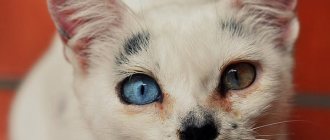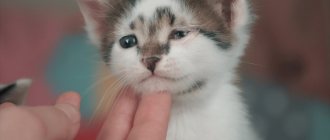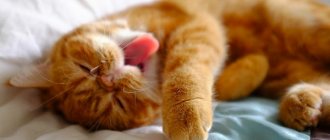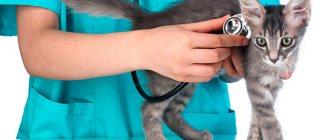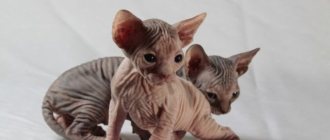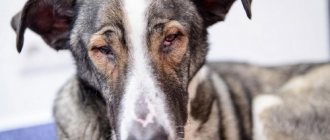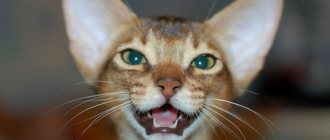Causes of pus discharge from the eyes
There are many reasons why cats' eyes begin to fester. Untreated conjunctivitis can play a big role, when the treatment process was not carried out properly, or it was not completed until the animal fully recovered. In this case, acute conjunctivitis, as the pathological process develops, turns into purulent, parenchymal or follicular, the main symptoms of which are the discharge of pus.
Another important point in the appearance of purulent discharge from the eyes can be called injuries or bruises of the eyelids, when the inflammatory process spreads to the eyeball. Many factors contribute to the occurrence of injuries: fights, bumping into sharp objects during games, and much more.
As a rule, any eyelid injuries are accompanied by damage to the conjunctiva. Foreign objects that get inside irritate the mucous membrane of the eye, causing inflammation. The danger of such damage is that foreign bodies can affect the sclera and cornea, opening the gates for the penetration of pyogenic infection.
Sometimes in cats you can find a disease such as blepharitis, which occurs due to traumatic, chemical, and thermal effects on the eyelids. As a result of such damage, microbes, viruses, and pathogenic fungi can penetrate into the eye, thereby infecting it.
Keratitis, or inflammation of the cornea, is another disease that can be accompanied by the discharge of pus from the eyes.
The nature of purulent discharge, as well as the general condition of the furry pet, depends on the main reason that led to its appearance:
- Bruised eyelids. In this case, bruising with possible crushing of adjacent tissues will be observed. Sometimes necrosis may form. There is a painful, hot to the touch swelling in the eye area.
- Wounds of the eyelids. In this case, gaping, bleeding, pain, and disruption of the integrity of the eyelid are detected.
- Blephoritis may be accompanied by itching and redness of the edges of the eyelids. Itching causes the cat to honor the eyes, thereby further aggravating the situation. Pyogenic microflora penetrates the eye, most often staphylococci or streptococci. The eyelids may be swollen.
- Purulent conjunctivitis. With such pathologies, both eyes are most often affected, the process is accompanied by depression of the cat, pain and an increase in local temperature in the eye area. The purulent discharge is initially liquid, then becomes thick. The conjunctiva is swollen and can sometimes protrude beyond the eye.
- Follicular conjunctivitis. Damage to the lymph nodes on the inner surface of the third eyelid is accompanied by purulent discharge from the conjunctival sac. The eyelids are swollen, there is pain and photophobia.
Signs that should alert owners and force them to seek help from a qualified veterinarian:
- when pus is discharged from the eyes, eyelashes stick together, fall out, and crusts may form that prevent the eye from opening;
- As a result of the constant leakage of pus, the skin in the eye area becomes inflamed, hair falls out, and eczema and dermatitis develop.
Which breeds are predisposed to inflammatory eye diseases?
There are cat breeds that are susceptible to increased tearing, which can lead to inflammation. Inflammatory eye diseases most often occur in Sphynx cats. Due to the inversion of the eyelids, these animals often develop chronic conjunctivitis. In addition to the Sphynx, this group includes the Scottish Fold and the British. In the Scots and British, increased tear production is due to the structural features of the muzzle - a narrowing in the area of the bridge of the nose.
Maine Coons, Persians and Exotics also often suffer from inflammatory eye pathologies. If you do not take care of the eyes of such pets, tears flowing down the fur can cause inflammatory dermatological pathologies.
Animal breeds bred by humans are predisposed to a number of diseases. As a result of genetic characteristics and a tendency to ophthalmological disorders, the British cat often has watery eyes.
There are many reasons for this phenomenon, but with proper treatment and prevention they can be completely eliminated.
Diagnostics
The diagnosis is made based on a thorough examination, analysis of clinical signs, medical history and laboratory tests. Under no circumstances should you try to find out on your own the reason that provoked the appearance of purulent discharge from the eyes, and even more so you should not treat the disease without the help of veterinary specialists.
Purulent discharge must be sent for examination to the laboratory to determine the infectious origin and test for sensitivity to antibiotics.
Treatment of purulent discharge consists primarily of eliminating the cause that caused the pathological process to begin. The purpose of treatment will depend on the correctly identified cause:
- If the cause of the appearance of pus is a bruise, then this area is thoroughly cleaned using gauze swabs soaked in a 3% solution of hydrogen peroxide. This must be done quite carefully so as not to further injure the conjunctiva. Then the eye is washed with a solution of potassium permanganate and eye drops with antibiotics are instilled.
- In case of eyelid injuries, proceed in the same way as in the treatment of bruises.
- In case of blepharitis, the cause is immediately eliminated. The cat is placed in a clean, well-ventilated room. A balanced diet is also important, since sometimes blepharitis can be caused by vitamin deficiencies. If there is a gluing of the eye with dried crusts of pus, they are softened with Vaseline oil. After this, they are removed with a swab soaked in a 3% hydrogen peroxide solution. The eye is washed with furatsilin and eye drops are instilled. You can also use eye ointments. In case of severe pain, 0.5% novocaine with an antibiotic is injected into the conjunctival sac. In cases where the process penetrates into the deeper layers of the eye, general antibiotic therapy is indicated.
- For purulent and phlegmonous conjunctivitis, general and local treatment is carried out. The eye is washed 2-3 times a day with a 3% aqueous solution of boric acid, after which 5-10% syntomycin emulsion or any other eye ointment with antibiotics is placed under the lower eyelid. It is advisable to carry out anesthesia, for which a special novocaine blockade with an antibiotic is placed, which also has a therapeutic effect. Antibiotics are administered intramuscularly, and sulfonamide drugs can be given orally.
Author of the article: Marina Chuprinina, veterinarian, specialization parasitologist-bacteriologist, especially for Kota Obormot.
Thank you for subscribing, check your inbox: you should receive an email asking you to confirm your subscription
As a rule, any eyelid injuries are accompanied by damage to the conjunctiva. Foreign objects that get inside irritate the mucous membrane of the eye, causing inflammation. The danger of such damage is that foreign bodies can affect the sclera and cornea, opening the gates for the penetration of pyogenic infection.
Diagnosis
Diagnosis is available only to a qualified veterinary hospital worker after an initial examination and examination of test results. Self-diagnosis, as well as treatment, can cause serious consequences for the cat. After all, even with certain diagnostic skills, without laboratory tests you cannot be sure of the final diagnosis. Also, it is impossible to independently determine the individual tolerance of drugs during treatment.
You cannot self-medicate; only a doctor can choose the right medications.
The cat's eye is rotting
There are different tips on how to deal with pus in the eyes of cats, cats and kittens. All tips can be applied in practice, but any pet owner needs to understand that ignorance of the characteristics and causes of the problem can cause improper treatment and deterioration of the pet’s condition, so a trip to the veterinarian is mandatory in any situation.
It is recommended that you familiarize yourself with the questions that cat owners most often ask when pus appears in the eyes, so that you know what you have to deal with in practice.
The cat has a festering eye and nose, sneezing, runny nose
One of the reasons for sneezing, runny nose and purulent eyes in cats can be a cold. It is necessary to treat a cold animal by creating greenhouse conditions for it and improving its diet. Warming the nasal area with hot salt or sand wrapped in a piece of cloth and instilling a 1% soda solution into the nose helps eliminate a runny nose and sneezing. In the fight against conjunctivitis, eye drops and ointments are effective - sofradex, tetracycline, chloramphenicol. However, it will be much better if you hear such recommendations from the lips of a veterinarian.
The cat's eye is festering and does not open, the eyelid is swollen
If a cat’s eye is festered and cannot open, or the eyelid is swollen, then there is a high probability of a foreign body getting into the eye, which means that professional intervention is indispensable. Every hour of delay can result in deterioration of vision or its complete loss.
We recommend reading: How to Properly Give Brevers to a Cat
The cat's eye is festering, swollen and red, his cheek is swollen, what should I do?
The diagnosis of the disease with such serious symptoms can only be made in a veterinary clinic where there is special equipment. The cat may need to have an x-ray, an MRI, or a needle biopsy taken. To prevent the cat from scratching the tumor, it is necessary to wear a collar.
A cat's eye is festering after a fight, from birth what to treat and rinse, drip
Suppuration of a cat's eyes is often caused by a bacterial or viral infection, so curing only the external manifestations of the disease can only worsen the general condition of the animal. The nature of the disease is established after taking swabs from the conjunctiva. Based on the test results, the most effective treatment path will be chosen. When providing first aid to an animal, you can wash the eyes with a cotton swab dipped in solutions of furatsilin or pale pink manganese.
A cat's eyes are festering, treatment and how to treat it, what to apply at home
To treat purulent eyes, prepare a washing solution - dilute manganese to a pale pink color or furatsilin (1 tablet per 100 ml of water). The eyes are treated separately, each time using a new gauze swab (vyta fibers can cause additional irritation to an already inflamed eye). Direction: from outer corner to inner corner.
To apply eye drops, the animal is laid on its side and its head is turned up. All you have to do is gently hold your eyelids and drip in 2-3 drops of the medicine prescribed by your doctor.
The cat's eyes are festering, treatment with folk remedies
The most common folk remedy for eye suppuration is a decoction of the herbs chamomile, eyebright, calendula, or pharmaceutical hydrocortisone or tetracycline ointment,
The cat's eyes are festering, what drops to buy, tetracycline, albucid, antibiotic, chloramphenicol, sulfacyl
In principle, the listed medications - tetracycline, albucid, chloramphenicol and sulfacyl - are suitable for the treatment of suppuration in the eyes of a cat. To which of them the viruses and bacteria that cause the disease will be more sensitive, conclusions can only be drawn by analyzing the conjunctival wash.
The cat has festering eyes, does not eat or drink anything, is lethargic for a very long time, has no appetite, how to cure it
A panacea for all diseases has not yet been found, either for animals or for people. Symptoms when a cat’s eyes fester, he doesn’t eat or drink anything, is lethargic for a very long time, has no appetite, accompany many infectious and chronic diseases, which means a visit to the animal clinic cannot be avoided.
Why does a cat's eyes fester, causes, worms after injury and what to drip
The reason that a cat’s eyes are festering may be: - mechanical injury or bruise; - reaction to irritation by acids or toxic fumes; - disease caused by infection or helminths; - damage to the conjunctiva and penetration of pathogenic microorganisms into it; - an inflammatory process that affects areas adjacent to the eye. Instilling eye drops even with the best drug will not give the expected effect until the root cause of the disease is eliminated and cannot be done without the help of a veterinarian. Only a doctor can tell you what to drip in each specific case.
The cat has white pus in his eyes, how to help
If a cat develops purulent discharge from the eyes, the animal should be immediately shown to a veterinarian. As a first aid, you can wash your cat’s eyes with a chlorhexidine solution of 0.05% or with plain boiled water, and then drop a couple of eye drops - “Iris”, “Diamond Eyes” or “Leopard”, and blot the fur around the animal’s eyes dry with a napkin.
Is it possible to wash the cat's eye with chlorhexidine?
Chlorhexidine is a cheap and effective drug with an antibacterial effect. To wash the eyes, use a 0.05% aqueous solution of the drug. Note the difference - chlorhexidine is used as a rinse rather than as an eye drop. Those. A cotton swab is generously moistened in the solution and rubbed over the hair around the eyes in order to soak and remove dried purulent crusts.
A cat's eyes are festering, can a person become infected?
Purulent discharge from a cat’s eyes is a symptom of various diseases of a parasitic or infectious nature, so the possibility of human infection with them cannot be ruled out.
A panacea for all diseases has not yet been found, either for animals or for people. Symptoms when a cat’s eyes fester, he doesn’t eat or drink anything, is lethargic for a very long time, has no appetite, accompany many infectious and chronic diseases, which means a visit to the animal clinic cannot be avoided.
What to do if your eyes fester with a runny nose
If a kitten has a runny nose and festering eyes, this does not mean that this will all end. After all, such deadly diseases for a young body as calicivirus and viral rhinotracheitis begin with a runny nose. Therefore, timely diagnosis in this case is an important factor.
A runny nose may also be of an allergic nature or indicate bronchial asthma. Each individual situation requires a specific approach to treatment, which is why diagnosis is a priority here too.
As soon as you see that your kitten’s eyes and nose are festering, consult a doctor. Each animal is a small individual, and if your neighbor’s cat got away with a slight illness after a runny nose, this is not evidence that everything will go well for you. Do not forget that we are talking about a baby with weak immunity.
Purulent discharge of a cold nature is treated with antibiotics, anti-inflammatory drugs and immunomodulators. Much attention is paid to preventive measures - eliminating possible drafts and hypothermia of the pet.
When should a pet be treated?
Sometimes a healthy cat will discharge fluid or even pus. This can occur after prolonged sleep, inappropriate food, or an allergy to household chemicals or perfumes. The eyes of a British cat often fester due to the structural features of the muzzle and the shortened tear duct. If the discharge of pus is sporadic and goes away after washing, then there is nothing to worry about. But you should consult a doctor if you notice the following symptoms:
- the cat is restless and rubs its eyes with its paws;
- the eye is red or cloudy;
- the animal refuses food and hides in a dark place;
- the cat has a fever or has started vomiting and diarrhea;
- pus flows heavily and the muzzle around the eyes is wet all the time;
- the animal's eyelids stick together and swell;
- Due to the constant flow of pus, fur on the face began to come out.
Symptoms
This pathology is accompanied by a number of other symptoms:
- the animal loses its appetite, becomes lethargic, sleeps longer than usual;
- temperature rises;
- due to the fact that the eyes become more sensitive to light, the cat tries to hide in a dark place;
- eyes are squinted or closed almost all the time;
- a specific smell is felt;
- a runny nose and occasional cough may appear; the mucous membrane turns red;
- anxiety appears, the cat constantly tries to rub the sore eye with its paw;
- the fur around the inflamed organ of vision darkens;
- A brown crust may form on the eyelids, preventing the eyes from opening fully.
In the presence of viral diseases, fever is observed for a long time.
Discharge can be cleaned off carefully
A cat's eye is festering - what to do?
Every owner should know how to provide first aid to their pet. After all, many eye diseases are accompanied by itching or pain, and the animal suffers. Often a cat cannot open her eyelids due to the released pus. The owner’s task in this case is to carefully wash the pet’s eyes. To do this, take a warm solution of furatsilin or boric acid. A decoction of chamomile, sage, St. John's wort, calendula or tea leaves are also suitable. Dampen a cotton swab and gently squeeze it over your cat's eye. It is advisable that someone hold her at this time.
You can gently, without pressing, wipe off the pus by moving the swab from the outer corner of the eye to the inner. Try not to touch the eyeball to avoid injuring it. Do not use cotton swabs or very hot solution for rinsing. Try to carry out the procedure when the cat is not very excited and does not break out, otherwise you can injure it.
Eye diseases typical for the breed
It is not uncommon for a British cat to have watery eyes due to a common cold caused by sitting in a draft. The presented breed has a “weak spot” and these are the eyes, so sometimes the problem can make itself felt even when, it would seem, there are no provoking factors.
Conjunctivitis
If a Brit's eyes are watery, conjunctivitis may be suspected. The trouble occurs due to inflammation of the eye membrane, which is caused by various pathogens. For the disease to make itself known, it is enough for the animal to rub its muzzle on dirty shoes, for example.
How can you treat your pet yourself?
Have you noticed that your cat's eye is festering? You need to know what to do to help the animal. If the cat feels well, there is not much pus released and its behavior has not changed, it is possible to begin treating the animal yourself. Wash your cat's eyes several times a day and apply special drops. For example, Tsiprovet, which can be purchased at a veterinary pharmacy, helps a lot.
We recommend reading: Toy Terrier Encephalitis Symptoms
If suppuration occurs due to mechanical damage or a foreign body entering the eye, try dripping levomecithin drops or “Iris” after rinsing. If you don’t have any veterinary medications, you can use Albucid or 1% tetracycline eye ointment, which is placed under the lower eyelid and then gently massaged into the eye.
To wash your cat's eyes, purchase a special animal care lotion. “Phytoelita” treats various diseases best. Do not forget about immunostimulating drugs and vitamins, as well as a balanced diet.
But if a cat’s eyes fester for a long time, a doctor should prescribe treatment. Indeed, often this condition can be caused by various infectious or viral diseases or injuries. Therefore, before carrying out treatment, it is necessary to establish the cause of suppuration. And only after this the veterinarian will prescribe medications, often antibacterial or antiviral.
Rinse the cat's eyes: useful tips
If a kitten's eye is swollen and festering, rinsing should be done carefully, having first taken care of your safety. During the procedure, the pet will be nervous and struggle, so it should be well secured (or use the help of a second person who will hold the animal). The best option is to swaddle the cat with a towel or diaper so that only the head remains outside. Please also adhere to the following recommendations .
- Rinse each eye with solution from a separate container.
- Twist the cotton wool into a tight rope, dip it in a warm broth (medicinal solution), and squeeze it onto the animal’s festering eye.
- When the pet's eyes are completely cleared of purulent discharge, apply tetracycline ointment (1%) under the cat's eyelid. To do this, pull back the animal’s lower eyelid and, using a special spatula, place the composition on its inner surface. Then close your cat's eye completely and massage it lightly. This will help the product to be distributed evenly. To further enhance the effect of using the ointment, preheat the tube with it in your hands. But if the cat is very nervous, then you should not apply the ointment under the eyelid (this can lead to injury to the organ of vision).
© shutterstock
What treatment does the doctor prescribe?
After carrying out the necessary tests, the veterinarian prescribes medications that will cure exactly the disease that caused the suppuration. For example, without eliminating the cause of the allergic reaction, it is useless to wash the cat’s eyes and drip them; pus will still appear. And if suppuration is caused by toxoplasmosis or chlamydia, antibiotic therapy is necessary.
For local treatment, the following drugs are most often prescribed: “Bars”, “Iris”, “Mizofen”, “Neoconjunctivet” or “Anandin”. You can also rinse your eyes from pus with special solutions purchased at a veterinary pharmacy. It is best to use Lakrimin or Medkinos.
How to put drops in a cat's eyes
To carry out this procedure, it is not necessary to go to the veterinary clinic every time. Owners can cope with this task on their own by following simple rules:
- place the cat on its side, turning its head up;
- if the animal resists them restlessly, it is necessary to limit its mobility before applying eye drops. Wrap it in a sheet or large towel;
- To instill the medicine, open your eye slightly. At this time, the muzzle must be held so that the animal does not turn its head;
- After the drops enter the eye, the cat will begin to blink. This is a natural reflex movement, due to which the medicine is evenly distributed;
- To remove excess medication, you need to gently blot your eye; a dry cloth or cotton pad is suitable for this.
The use of drops is only a way to relieve symptoms when pus is discharged. They will not be able to cure the disease that caused it.
Eyes need to be washed and wiped
How to protect your cat from eye diseases
Eye diseases are very dangerous because they can lead to vision loss. Many of them take a very long time to cure and require frequent washing and instillation, which is unpleasant for the cat and causes problems for the owners. Therefore, it is easier to warn them. To do this, watch your pet’s diet, wash the eyes daily with hygienic solutions or just boiled water, trim the cat’s claws and play with it more carefully so as not to injure the eyes. It is necessary to support the immune system with vitamins and carry out deworming and vaccination on time. Then you won’t have to worry about the question: the cat’s eye is festering - what to do?
If suppuration occurs due to mechanical damage or a foreign body entering the eye, try dripping levomecithin drops or “Iris” after rinsing. If you don’t have any veterinary medications, you can use Albucid or 1% tetracycline eye ointment, which is placed under the lower eyelid and then gently massaged into the eye.
How to wipe and rinse a cat's eyes
Rinsing and rubbing help clear the eyes of purulent discharge. It is better to treat after consultation with a veterinarian. The doctor will recommend a remedy that is best suited for a particular situation.
When administering medicine or rinsing, the animal's face must be held
To carry out the procedure, the cat must be restrained. If the animal is calm, it is enough to hold it with your hand. If it is active and may show signs of aggression, it is better to wrap it in a sheet or towel, since sudden movements may cause injury to a person or the pet itself. It is best to do this together - one person fixes it, and the other does the rinsing.
If you have no experience, you can ask your veterinarian how best to wipe and rinse the eyes of your four-legged friend.
All movements must be light and careful, otherwise the organ of vision may be damaged. Slowly bring the swab in and the cat will close his eyes. This will eliminate the risk of injury to the cornea, which may cause ulcers or damage to the integrity of the retinal surface. It is more advisable to position yourself on the side so that the animal does not perceive the owner’s actions as an act of aggression. Do not put too much pressure on the area around the eye, as this is a very sensitive area.
Rub downwards and outwards (from the inner to the outer corner of the eye). If done in the opposite direction, dirt and infection may get inside.
If your pet suffers from dermatitis or skin irritation that causes discharge to appear in the inner corners of the eyes, a special moisture-repellent agent is applied after wiping. It can be regular or contain an antibiotic. This medicine is prescribed by a veterinarian. This drug protects delicate skin from constant secretions.
Cleaning is carried out before instillation or ointment is applied, otherwise all the medicine will be washed off.
Care must be taken to ensure that the animal does not injure its eyes.
Causes of festering eyes in cats
There are quite a large number of reasons why a cat’s eyes begin to fester. The main cause of the formation of pus in the eyes is untreated conjunctivitis, when the owners treat the pet improperly or do not carry out the full course of treatment prescribed by the doctor. In this case, acute conjunctivitis turns into a purulent, follicular or parenchymal form. Signs of these forms of conjunctivitis are purulent discharge.
Purulent discharge from the eyes is the first sign of the disease. You should immediately rinse your eyes with herbal infusions, such as chamomile, and contact a veterinary clinic.
In addition, the appearance of purulent discharge may be associated with the cat receiving an injury, for example, with a bruise to the eyelid. Cats get injured during fights, bump into sharp objects during play, and the like. If the eyelid is severely injured, the inflammatory process can spread to the eyeball, resulting in the formation of pus. Most often, when an eyelid injury occurs, the conjunctiva is damaged.
The cause of damage to the eye can be the entry of a foreign body into it, which irritates the mucous membrane of the eye, resulting in inflammation. The danger of this kind of damage is that a foreign body can damage the cornea or sclera, which opens the door for a pyogenic infection to enter the eyes.
As a result of traumatic, temperature and chemical effects on the eyelid, a cat may develop blepharitis. Damage to the eye allows the penetration of viruses, microbes and pathogenic fungi, which cause infection.
Another eye disease in cats that causes pus to form in the eyes is keratitis, or inflammation of the cornea.
The intensity and nature of purulent discharge from a cat’s eyes depend on the cause of its occurrence. There are certain signs characteristic of festering eyes that should alert the cat owner and force them to take their pet to a veterinary clinic:
With bruises of the eyelids, bruising is observed, and the adjacent tissue may be damaged. In some cases, necrosis occurs. The animal develops a tumor in the eye area that is hot to the touch, which causes pain in the cat when touched;
With wounds of the eyelids, bleeding, gaping and disruption of the integrity of the tissue appear. All these symptoms are accompanied by severe pain;
With purulent conjunctivitis, pus usually forms in both eyes. This disease causes an increase in the cat's body temperature, pain and depression. At the initial stage, the pus is liquid, and then it thickens. Sometimes the conjunctiva swells so much that it protrudes beyond the eye;
With follicular conjunctivitis, the lymph nodes on the inner surface of the eyelid are affected. As a result, pus is released from the conjunctival sac. The cat's eyelids swell, the eyes hurt, and there is photophobia;
Blephoritis causes redness of the eyelids, accompanied by itching. Because your cat's eyes are itchy, she scratches them, which makes the situation even worse. Streptococci and staphylococci get into the eye. With blepharitis, the eyelids may swell.
With purulent discharge, a cat's eyelashes stick together, as a result they fall out, and the formation of crusts prevents the eye from opening. Purulent discharge causes inflammation of the skin in the eye area, hairs fall out, and dermatitis and eczema form.
A veterinarian diagnoses cats based on an external examination, clinical symptoms, collection and examination of tests. Under no circumstances should you try to determine the cause of the pathology yourself, especially since it is not recommended to treat your pet on your own, since complications can be very serious.
The doctor sends a sample of purulent discharge to the laboratory, where the type of infection and sensitivity to antibiotic treatment are determined.
Treatment of pathology
Before starting treatment, you should find out the reasons why your British kitten's eyes are watery. Only in this case will it be possible to choose the right treatment tactics that will have the desired effect. Usually you can do without a veterinarian, but in some cases a trip is necessary.
We are talking about symptoms such as:
- profuse purulent discharge from the eyes;
- refusal of water;
- vomiting foam;
- weakness and elevated body temperature;
- complete lack of appetite.
If this is not the case, then you can rule out serious infections and try to help your pet on your own.
First aid for watery eyes is rinsing. Tea leaves are an excellent folk medicine; they should be as strong and dark as possible. The procedure should be carried out several times a day.
In addition, you can pay attention to the following methods and recipes:
- Herbal infusions or manganese water. As for herbs, chamomile, St. John's wort, sage or calendula are best. If manganese is used, then there should be a little of it so that the water only turns slightly pink.
- Tetracycline ointment. It can be used if an infection has made itself known. The ointment is applied to the cat's eyelid and left overnight.
- Drops. The PhytoElite eye lotion, which is intended for people, as well as Iris drops, have proven themselves to be excellent. How to use the drugs can be read in the instructions.
Important! It is necessary to carry out eye treatment only with clean hands, following the rules of hygiene. Otherwise, you can only worsen the condition.
If the problem appears in only one eye, you still need to rinse both, because the infection will quickly spread to the second. The eye should be treated carefully but thoroughly, using a new cotton pad each time. The movements should start from the top and end towards the edge (towards the nose).
Treatment of purulent eyes in a cat
Therapy begins first of all with eliminating the cause that provoked the pathological process. The success of treatment will directly depend on this.
We recommend reading: Why the Cat Howls in the Morning
If the painful condition was caused by a bruise, then the damaged area is cleaned with cotton wool soaked in a 3% solution of hydrogen peroxide. This procedure must be carried out with caution so as not to further damage the conjunctiva. After treatment, the eyes are washed with potassium permanganate, and at the final stage, liquid antibiotics are dripped. If the eyelid is wounded, then similar treatment is carried out.
In case of blepharitis, it is necessary to determine and immediately eliminate the cause. The cat must be kept in a clean room that must be ventilated. Particular attention should be paid to nutrition, since blepharitis provokes vitamin deficiencies. If the eye sticks together and crusts form, they are softened with petroleum jelly and then removed with cotton wool soaked in a 3% solution of hydrogen peroxide. Then you need to rinse the eye with furatsilin and apply eye drops; eye ointments are also suitable. If the cat has severe pain, the doctor injects 0.5% novocaine with an antibiotic into the conjunctival sac. If the pathological process has affected the deep layers of the eye, general antibiotic therapy is used.
If phlegmonous or purulent conjunctivitis has developed, local treatment will be performed. At this time, you should wash your cat's eyes with a 3% aqueous solution of boric acid several times a day. After this, an eye ointment with antibiotics is applied, for example, 5-10% syntomycin emulsion. Pain relief is often required using a novocaine blockade with an antibiotic, which not only relieves the pain symptom, but also has a therapeutic effect. Sulfonamide drugs are given orally and antibiotics are injected intramuscularly.
If you find an error, please select a piece of text and press Ctrl+Enter.
In case of blepharitis, it is necessary to determine and immediately eliminate the cause. The cat must be kept in a clean room that must be ventilated. Particular attention should be paid to nutrition, since blepharitis provokes vitamin deficiencies. If the eye sticks together and crusts form, they are softened with petroleum jelly and then removed with cotton wool soaked in a 3% solution of hydrogen peroxide. Then you need to rinse the eye with furatsilin and apply eye drops; eye ointments are also suitable. If the cat has severe pain, the doctor injects 0.5% novocaine with an antibiotic into the conjunctival sac. If the pathological process has affected the deep layers of the eye, general antibiotic therapy is used.
Why do a kitten's purulent eyes swell up?
There are several possible reasons for the described symptoms:
- allergy;
- chlamydia;
- mycoplasmosis;
- toxoplasmosis;
- calicivirus infection;
- herpes virus infection, etc.
To find out what infection has affected the kitten, a PRC diagnosis will be required, and only after the diagnosis has been clarified can treatment of the animal begin. You should also consider factors such as:
- time of last deworming;
- time of the last vaccination of the animal, type of vaccine;
- what additional vitamins were used to strengthen the body.
Please note that feeding a kitten with economy class food is not recommended. And we are talking about any product: both wet and dry food. It has been proven that consumption of these products by a pet provokes gastrointestinal diseases, which leads to the development of infections affecting the eyes.
Why do such symptoms occur?
Why a cat's eye festers is interesting to know for many whose pet suffers from such an illness. The following main reasons are identified:
- Conjunctivitis. If a kitten's eyes are festering, then most likely this is a consequence of a viral or bacterial infection. In this case, the process develops quite quickly, and the animal’s eyelids constantly stick together, and the discharge from them is purulent in nature.
- Injury. When your pet doesn’t like to sit still, you shouldn’t ask why the kitten’s eye is festering. This can occur with minor injury from a nail or some object.
- Keratitis. If an inflammatory process occurs in the cornea, then pus from the eyes becomes a constant companion. At the same time, it is important to suspect the pathology in time and begin treatment.
- Avitaminosis. Lack of nutrients and poor nutrition can lead to weakening of the animal’s body. As a result, even a minor infection can lead to suppuration.
- Congenital developmental anomalies. Sometimes, immediately after birth, an animal has such a problem. This is due to congenital malformations of the hair follicles.
- Chlamydia. The presence of protozoa in a pet's body can cause pus to discharge from the eyes. Treatment of chlamydia is long and requires an integrated approach.
- Allergy. If a cat's eyes fester, this may be a consequence of a pathological reaction of the body to some food product, plant or other component of the external environment.
- Hypothermia. A common cold can provoke this kind of symptomatology. If a cat's eyes have become suppurated, then the animal may have been frozen for a long time.
Prevention
It is necessary to prevent infectious diseases. First of all, you need to get all the necessary vaccinations for your four-legged friend. Don't forget to check on your pet from time to time. And it will never be superfluous to visit the veterinarian’s office for preventive purposes.
To avoid injury to the animal, supervise it while walking. And if your pet is prone to inappropriate behavior, walk him on a harness. Remember right away that if a cat’s eye festers after a fight, there is nothing to be surprised about. There is obvious damage to the organ by debris or the claws of the enemy. If any situation does lead to damage to the eye, do not delay with first aid, treat the affected area as soon as possible. Regarding how to wash a cat’s eyes if they fester, everything is simple - you can use boiled water or a herbal decoction.
Don’t forget about such an item as deworming. Worms cause double harm to the animal. In addition to the main parasitic factor, helminths harm the animal by poisoning it with the products of their vital activity. And if a cat’s eye is watery and purulent, this is one of the signs of an allergic reaction caused by the activity of worms.
If for any reason the animal injures the area near the eye, take measures to ensure that the pet does not scratch the affected area. An Elizabethan cat collar works well for this purpose. If desired, you can do it yourself.
If you have a long-haired cat at home that is prone to eye infections, trim the hair around her eyes - this will be a good preventive measure and a possible panacea for unwanted discharge.
In general, if you are interested in knowing why a cat’s eyes fester, first of all think about how caring you are towards your pet:
- do you vaccinate it;
- anthelmintic;
- carry out preventive examinations.
After all, timely care of the animal and care for minor injuries help to avoid many complications, including problems affecting the cat’s eyes.
What eye drops are there for cats?
global $ads_google; //data-ad-slot=”2475549904″ $ads_google = empty($ads_google) ? false : true; ?> if ($ads_google == false) {?>
$ads_google = true; ?> } ?>
Mechanical injuries, inflammation, swelling, keratitis, lacrimation - any problem requires timely use of eye medication. To choose the right drug, you need to consult a veterinarian. Only he can determine the cause of the disease and choose the appropriate medication. The active component of the drug determines the main effect and type of eye drops.
Anti-inflammatory
Local inflammation of the mucous membrane and tissues around the eye can be caused by various reasons (bacterial infection, allergies, trauma). Characteristic signs are redness, lacrimation, swelling, and pain. Anti-inflammatory eye drops for cats help reduce negative symptoms. Most drugs of this type are also included in other categories of ophthalmic drugs.
An example of anti-inflammatory drops is Anandin. The drug helps reduce exudation, cell proliferation, and wound healing. Thanks to the unique formula, eye drops are also used for complex immunodeficiency conditions in animals. For conjunctivitis, the medicine is used in the morning and evening, two drops under the eyelid. The standard course of treatment ranges from 5 days to two weeks. In rare cases, these eye drops cause side effects such as itching, skin rashes, increased swelling, hair loss, and weakness.
Antiseptic
Eye drops from this group are indicated for bacterial or fungal infections. Antiseptic components help sanitize the mucous membrane of the eyeball and eyelids, reducing the amount of pus. Disinfecting the affected area speeds up the fight against germs and the cat’s recovery. Extracts of medicinal plants (chamomile, thyme, string, birch, calendula) or chemicals (chlorhexidine bigluconate, polysept) can act as antiseptics. Antiseptics include Lakrikan, Ophthalmosan, Barrier.
Eye drops for cats Barrier, in addition to the antiseptic effect, have an antiallergic and anti-inflammatory effect. The active components cause the death of many microorganisms (gram-positive and gram-negative bacteria). The liquid is instilled 2-3 drops twice or thrice a day. Treatment lasts 5-7 days.
Antiviral
If the disease is viral in nature, solutions containing interferon or its inducers (interferonogens) help. Antiviral drops act on non-cellular pathogenic particles indirectly through the animal’s immunity. Due to its immunomodulatory effect, the medicine helps to cope with the pathological process. To prevent bacterial infection of a cat’s organ of vision, veterinarians prescribe antibiotics in parallel. Popular products in this group are Maxidin, Forvet and Anandin.
The spectrum of action of Maxidin includes antiviral, anti-inflammatory, and regenerative components. The active components improve metabolic processes in the cornea of the eye and trigger phagocytosis, as a result of which viral proteins are destroyed. The medicine is instilled for infections of various etiologies, allergic manifestations, inflammation after injuries.
Antibacterial
global $ads_google; //data-ad-slot=”2475549904″ $ads_google = empty($ads_google) ? false : true; ?> if ($ads_google == false) {?>
$ads_google = true; ?> } ?>
Antibiotic drops are part of the complex treatment of bacterial infections. The active component of the formula are semi-synthetic or natural compounds. They inhibit the proliferation of bacteria and contribute to their death. Indications for the use of antibacterial eye drops for cats may be diseases accompanied by the release of pus. The most popular drugs include Bars, Tsirovet, Iris, Dekta-2, Tobrex, Levomycetin.
Many antibacterial drops are used not only for treatment, but also for prevention before and after surgery.
Iris eye drops contain a broad-spectrum antibiotic. It acts on both gram-positive and gram-negative bacterial flora. The medicine helps with complicated conjunctivitis, blepharitis, keratitis, uveitis, septic opacification of the cornea. A characteristic feature of the drug is its prolonged effect.
Moisturizing
Low air humidity in the room, the presence of harmful substances in the gas composition, and the physiological characteristics of the cat’s body can provoke increased dryness of the cornea. In this case, eye drops with moisturizing ingredients help. Their formula is close to the composition of natural tear secretion. Indications for the use of the drugs are redness of the eyes and tearing. For hygienic purposes, Diamond Eyes drops and Rosinka moisturizing lotion are suitable. The latter contains hyaluronic acid and D-panthenol.
For dry eye syndrome, veterinarians may recommend Bars for a cat. The composition includes antibacterial, anti-inflammatory, analgesic ingredients due to which the medicine has a wide spectrum of action. Leopard is effective for keratitis and drying of the epithelium after a foreign object enters the eye.
Antihistamines
Allergic conjunctivitis is accompanied by swelling, redness of the mucous membrane and eyelids, and increased production of tears. Such symptoms require the use of special eye drops that contain antihistamines. If urgent relief of the process is necessary, drugs with hormonal components are prescribed. They are used in complex therapy together with medications for internal use.
Among the remedies that help with allergies is Decta-2. Along with the antibacterial effect, this solution provides anti-edematous and anti-inflammatory effects. The result is due to the activity of synthetic analogues of glucocorticoids. The solution is instilled 2-3 times a day, 2-3 drops into each eye. The course of treatment is from 5 to 10 days.
Can cats get human eye drops?
Many pharmaceuticals intended for humans are not suitable for use in veterinary medicine. That is why independently prescribing a medicine for your pet that was purchased at a regular pharmacy is fraught with complications and side effects. However, some products can also be used for cats. These include Tobrex and Levomycetin. But in any case, the use of eye drops for a cat should be under the supervision of a veterinarian.
global $ads_google;
//data-ad-slot=”2475549904″ $ads_google = empty($ads_google) ? false : true; ?> if ($ads_google == false) {?> $ads_google = true; ?> } ?>
How to wipe pus from a cat's eyes at home
If you can’t see a veterinarian urgently, you can try to wash your pet’s eyes at home, easing the symptoms. For these purposes, folk remedies are used to relieve inflammation, relieve itching and remove pus:
- Infusion of chamomile. Prepare an infusion at home. Take dried chamomile flowers - 1 tbsp. l and pour 200 ml of boiling water. Let it brew for 15 minutes. Gently wipe the affected area with a cotton pad soaked in the infusion.
- Brewing strong tea. Infuse 2 sachets or 1 tbsp in 200 ml of boiling water. l black tea. Let it brew for 15 minutes and moisten a cotton pad with the resulting infusion, squeeze it lightly and wipe the corners of the eyes from the accumulated exudate.
- Saline solution. Dissolve 1 teaspoon of salt in 500 ml of hot water. Next, the solution is cooled to a comfortable temperature, a gauze (recommended) or cotton swab is moistened and the animal’s eyes are cleaned.
Preventive measures necessary to avoid eye diseases
Vaccinations and periodic deworming are universal ways to protect any animal. It is also important to consider the breed of the cat.
Some of them, such as the Sphynx, require increased attention to the skin. Having no fur, they are more susceptible to suppuration. Not only do they require daily care and eye washing, but they also need to repeatedly wipe their ears with a warm solution.
The opposite situation is the Persian breed with thick hair. In case of suppuration, snot and other mucous secretions, you should cut off the hair around the swollen organ and, after recovery, carefully ensure that the hair does not fall into the area of the former inflammation.
If infected, you should not allow the infectious animal to come into contact with your child or healthy pets; it is also important to remember your own safety measures when treating your eyes.
If the cause of eye discharge is an injury, then it is better to make an appointment with a veterinarian, undergo a full course of treatment, and also see a doctor regularly after that (preferably every month).
Daily animal care is the key to health. As a rule, it is difficult to train an adult cat to wash its eyes. However, for some breeds such safety measures are simply necessary due to their anatomical features, for example, Scottish Folds. Therefore, it is better to accustom your cat to such procedures from the first weeks of life.
Basic therapy and recommendations from veterinarians
If a kitten’s eyes are festering, the veterinarian will tell you what to do.
Treatment of purulent discharge is aimed primarily at eliminating the causes that caused this pathological process. Further therapeutic measures depend on how correctly they are installed. Treatment for purulent eyes in kittens depends on the reasons that caused the pathology. Veterinarians make the following treatment recommendations:
- When the cause is a bruise, the injured area is cleaned with a gauze swab, which is moistened in a solution with hydrogen peroxide. The same should be done if the eyelids are injured.
- In the event that the problem is blepharitis, then this cause is removed. It is worth knowing that blepharitis in kittens can occur due to vitamin deficiency, so if the doctor makes such a diagnosis, then it is necessary to provide the pet with a balanced diet with added vitamins. What else should you do with your eyes?
- A kitten's eyes often fester due to a cold, then the doctor will prescribe antibiotic drops. It is important to provide your pet with the most comfortable living conditions possible. The baby's crib must be dry and there should be no drafts in its location. Adding various vitamins to your animal's diet will be an excellent additional benefit for its health. What to put in a kitten's eyes if they are festering? Let's look further.
- If the cat’s eyes cannot open due to pus, the exudate crusts are softened immediately before removal. Vaseline oil is used for this. The softened crusts are removed, and the area near the eyes is treated with hydrogen peroxide. The eyes themselves are washed with “Nitrofural”, also known to many as “Furacilin”. After treatment, eye drops are instilled or ointment is used.
First aid
Kittens' eyes often fester, what should I do? Cats' eyes should not normally hurt.
A variant of the norm is the presence of only a small amount of discharge, which is characterized by a non-purulent nature of a cloudy milky or transparent shade in the inner corners. These occur for no particular reason and are not considered a consequence of the disease. Discharge may accumulate after the animal sleeps or after a walk. The alarm should be sounded when they become greenish or yellowish, then this can be regarded as a symptom of the disease.
Not everyone knows how to treat a kitten’s eyes if they are festering. If the animal has a discharge that is uncharacteristic of its normal condition, and its eyes are sore and inflamed, the kitten itself will require urgent help, regardless of the reasons for such symptoms. It is best to immediately go to the veterinarian, but the owner must also be able to independently provide first aid to his animal. Such measures alleviate the condition of pets and relieve inflammation in non-serious diseases.
It is necessary to first rinse the cat's eyes in order to free them from purulent accumulation. The cat may struggle, so you need to immediately wrap it in a towel or hold its paws with your hands. Ideally, this process can be performed by two people. When a kitten’s eyes fester, you should never clean them with dry cotton wool, this will definitely harm the inflamed organ. You should prepare a soft cloth; cotton pads with a medicinal composition for rinsing are also suitable.
If a kitten has festering eyes, what should you do? The answer to this question interests many.
A cat or dog scratches its eye: what to do?
In any case, it is worth showing the animal to a veterinarian as soon as possible. Edema can develop rapidly, within a few minutes, and threaten the life of the animal. Your first aid in this case can significantly alleviate the cat’s condition and improve the prognosis.
- If your swelling is hot and red, you can try applying cold and go to an appointment;
- If there is swelling of the muzzle or lips, try to give the animal an antihistamine (if you have one at home) and go to a veterinary clinic in Krasnoyarsk as soon as possible. It is better to clarify the dosage of the drug by calling our clinic 7(391)2-179-779;
- If you see your cat's breathing deteriorating due to swelling in the face or any other part of the body, try to provide air flow. See your doctor as soon as possible. If breathing stops, it is necessary to perform artificial respiration through a napkin, carefully opening your mouth with it.
At the clinic, the doctor will urgently examine the animal and provide symptomatic therapy aimed at stabilizing the condition, and then conduct additional diagnostics to make a diagnosis.
The cost of treatment depends on the diagnosis, for example, with allergic edema, several injections of antihistamines (from 100 rubles) and exclusion of allergens are usually sufficient.
Krasnoyarsk, Partizana Zheleznyaka str. 9g; 7 (391) 2-179-779
“A cat or dog scratches its eye: what to do?” - Every pet owner has probably asked this question. In most cases, the reason for this behavior of the animal is explained quite simply: your pet has contracted conjunctivitis.
